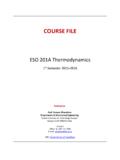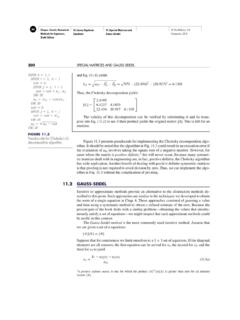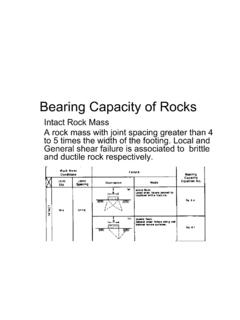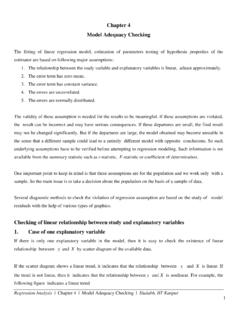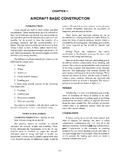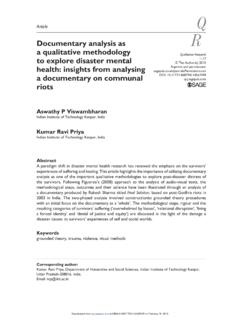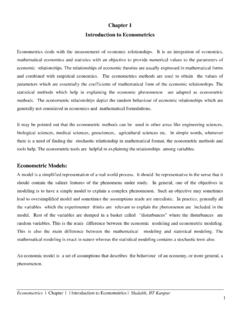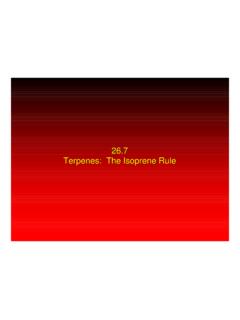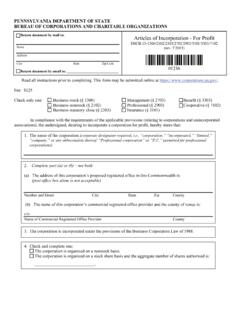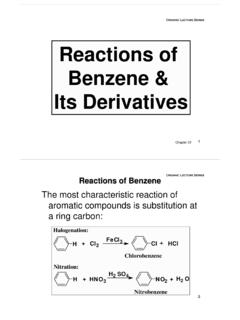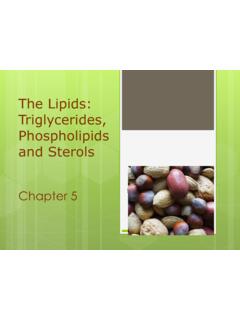Transcription of Elimination Reactions
1 Elimination ReactionsJust as there are two mechanisms of substitution (SN2 and SN1), there are twomechanisms of Elimination (E2 and E1).E2 mechanism bimoleculareliminationE1 mechanism unimolecular eliminationThe E2 and E1 mechanisms differ in the timing of bond cleavage and bond formation ,analogous to the SN2andSN1 and SN2 Reactions have some features in common, as do E1 and SN1 removes aproton from the -carbon atom,while the halogen atom leaves from the -carbonresulting in the formation of a - bond . Sucheliminationsarealsocalled -eliminationeliminationsarealsocalled eliminationreactionsThe Zaitsev (Saytseff) RuleWhen alkyl halides have two ormore different carbons, more than one alkeneproductis such cases, the major product is the more stable product the one with the moresubstituteddoublebond.
2 Thisphenomenon is calledthe Zaitsev Zaitsev product or the more substituted alkene product is more stable than the lesssubstituted product. The stability of the more substituted alkene is a result of number ofdifferent contributing factors, including alkyl group that can involve in hyperconjugation with the double bond stabilizesit by approximately 6 kcal/molThe E2 MechanismThe most common mechanism for dehydrohalogenation is the E2 exhibits second-orderkinetics,andboth the alkyl halide and thebase appearin the,ypprate equationrate = k[(CH3)3 CBr][HO ]The reaction is concerted allbonds arebroken andformedin a single Reactions are regioselectiveand favor the formation of Zaitsev Profile for an E2 ReactionCH2 HBH3CH3 CHOBr(CH3)3 CBr + OH (CH3)2C=CH2+ H2O + Br (3)
3 222 Factors Affecting the Rate of an E2 ReactiongThere are close parallels between E2 and SN2 mechanisms in how the identity of the base, the leaving group and the solvent affect the base appears in the rate equation, so the rate of the E2 reaction increases as the strength of the base Reactions are generally run with strong negatively charged bases like OH E2 Reactions are generally run with strong, negatively charged bases like OHand OR .Polar aprotic solvents increase the rate of E2 reactionsThere is a partial breaking of the bond to the leaving group in the transition state. So, the better the leaving group the faster the E2 of reaction follows the orderRate of reaction follows the order,R I > R Br > R Cl > R FFactors Affecting the Rate of an E2 ReactiongThe SN2 and E2 mechanisms differ in how the R group affects the reaction the number of R groups on the carbon with the leaving group increases, the rate ofthe E2 reaction increase in E2 reaction rate with increasing alkyl substitution can be rationalized interms of transition state the transition state, the double bond is partially formed.
4 Thus, the transition state fora more substituted alkene is lower in energy, reducing the activation energy for thereaction and making the reaction of an E2 ReactionKinetics Second orderMechanism Single stepIdentity of R group More substituted halides react fasterRate: R3CX > R2 CHX > RCH2 XStrength of the base Stronger bases favor the reactionLeaving group Better leaving group leads to faster reaction ratesreaction ratesType of solvent Favored by polar aprotic solventsE2 Reactions are stereoselective, resulting in the formation of trans-double bonds E1 MechanismThe E1 reaction proceeds via a two-step mechanism: the bond to the leaving groupbkfi tbfthbdifdThltiil lililbreaksfirstbeforethe stepisunimolecular,involving onlythe alkyl exhibits first-order kinetics,tk[(CH)CCl]rate = k[(CH3)3 CCl]E1reactionsalso are regioselective and follow ZaitsevruleE1 Reactions also are regioselective and follow Zaitsev ruleEnergy Profile for an E1 Reaction(CH3)3C---X +(CH3)3C+(CH3)3CX(CH3)
5 2C=CH2 + HXFactors Affecting the Rate of an E1 ReactiongThe rate of an E1 reaction increases as the number of R groups on the carbon with theleaving group 2 3 IncreasingrateofE1reaction123+++Iibilifb iRCH2+R2CH+R3C+1 2 3 Increasing stability ofcarbocationsThe strength of the base usually determines whether a reaction follows the E1 or E2mechanism. Strongbases like OH andOR favorE2 Reactions ,whereas weakerbasesg,like H2O and ROH favor E1 of an E1 ReactionKinetics First orderMechanism Two stepsIdentity of R group More substituted halides react fasterRate: R3CX > R2 CHX > RCH2 XStrength of the base Favored by weaker bases such as H2O and ROHL eaving group Better leaving group leads to faster reaction ,theratedeterminingstepinvolves the C X bond cleavageType of solvent Favored by polar protic solvents, which canstabilizetheionicintermediatesstabili zetheionicintermediatesSN1 and E1 ReactionsS1dE1tihtlthfi ttftifbtiSN1andE1reactionshave exactlythesamefirststep formation ofa differ in what happens to the in both the Reactions , the rate determining steps are the same, they cannot beindividually ,E1reactionsofalkylhalides are much less useful than E2 , SN2, E1 or E2N,N.
6 3 Alkyl HalidesWi hbE2li iiWithstrongbases:E2elimination occursWith weak nucleophiles or bases:A mixture of products from SN1 and E1 reactions1 Alkyl HalidesWith strong nucleophiles:Substitution occurs by an SN2 mechanismWith strong sterically hindered bases: Elimination occurs by an E2 mechanism2 Alkyl HalidesWithstrongbasesandnucleophiles:Am ixtureofSN2andE2reactionproductsareWiths trongbasesandnucleophiles:AmixtureofSN2a ndE2reactionproductsareformedWith strong sterically hindered bases: Elimination occurs by an E2 mechanismWithweaknucleophilesorbases:Ami xtureofSN1andE1productsresultsWithweaknu cleophilesorbases:AmixtureofSN1andE1prod uctsresultsStereochemistry of the E2 ReactionThe transition state of an E2 reaction consists of four atoms from the substrate (onehydrogen atom, two carbon atoms, and the leaving group, X) aligned in a plane.
7 Thereare two ways for the C H and C X bonds to be Elimination occurs most often in the anti periplanar geometry. This arrangementallowsthemoleculetoreactinthe lowerenergystaggeredconformationandallow sallowsthemoleculetoreactinthelowerenerg ystaggeredconformation,andallowsthe incoming base and leaving group to be further away from each anti periplanar geometry also allows direct interaction between the bondingelectrons ofC Hbondandthe anti-bonding orbital ofthe C Reactions in 6-Membered Rings ThthilitftiiltiE2tihThestereochemicalreq uirementofan antiperiplanargeometryinanE2reactionhasi mportant consequences for compounds containing six-membered ,theC ClbondmustbeantiperiplanartotheC Hbondona ForE2elimination,theCClbondmustbeantiper iplanartotheCHbondona carbon.
8 And this occurs only when the H and Cl atoms are both in the axial requirement for trans-diaxial geometry means that Elimination must occur from theless stable of cis-1-Chloro-2-methylcyclohexaneHH3 CHClHCCl3H3 CIn this conf ormer two Hs areanti periplanar to the this conf ormer Cl is in anequatorial psition and has noHs periplanar to conformer with Cl in an axial orientation reacts to give two alkenes. The alkenethat is more substituted is the major alkeneminor productCl3H3 CHHClH3CH3 Ctrisubstitutedalkenemajor productDehydrohalogenation of trans-1-Chloro-2-methylcyclohexaneThe conformer with Cl in an axial orientation has just one -H atom. Only one productis formed, which is not what is predicted by the Zaitsev ,withsubstitutedcyclohexanes,E2eliminati onshouldoccurwithatransdiaxial arrangement of the leaving group and the -H, and as a result of thisrequirement, the more substituted alkene is not necessarily the major in E2 reactionsStereospecificity in E2 reactionsDiastereomeric starting compounds yield diastereomeric products after an E2 reactionE1cB ReactionAli i titith thhdbiliAnelimination reactionthathappens when a compoundbearing apoorleaving groupand an acidic hydrogen is treated with a from the conjugate base of the starting compound.
9 Which in turn isformed by deprotonation of the starting compound by a suitable electron withdrawing group (EWG) canbe a carbonyl group (keto, aldehyde,ester), a nitro group, an electron deficient aromatic group etc. Dehydration of aldol isthe most common E1cB reactionHOHH2 OHOOHOOOOHOHO
